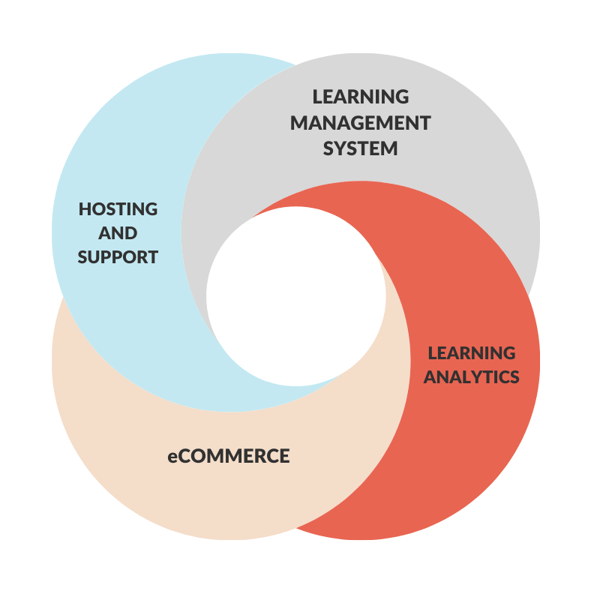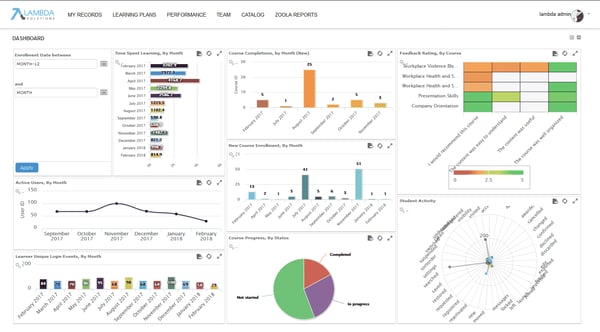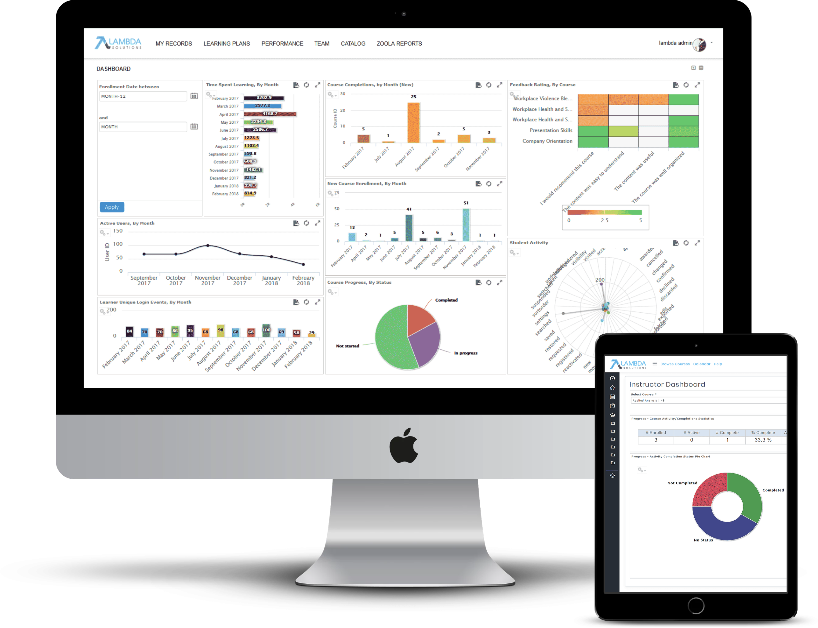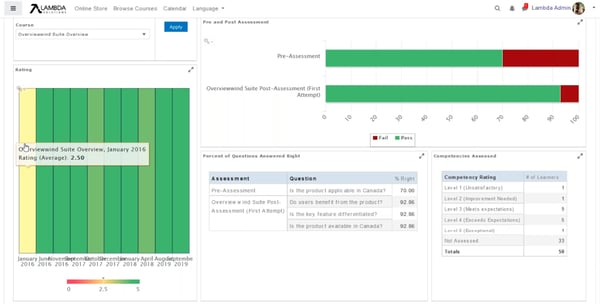From LMS integrations to choosing an eLearning company: Here are five business challenges you can overcome with the benefits of eLearning and online training.
Today, it’s hard to find an organization that’s not making use of eLearning in one way or another. But there’s a big difference between offering online training as a goodwill gesture for a digitally native workforce, and true eLearning integration.
Making your Learning Management System (LMS) the technical foundation of your entire training program is the secret to overcoming many of the biggest eLearning challenges.
In fact, good LMS integration can turn those potential issues into some of the strongest aspects of your training portfolio!
Whether it’s dealing with eLearning skeptics, finding a balance with blended learning programs, or choosing the right training platform for your team’s remote needs, today’s eLearning companies are on hand with data-led, cost-efficient solutions.
Of course, being a learning & development specialist is no easy task, no matter the technology you have on-hand. But for these five training challenges, you can rely on eLearning to provide the correct answer.
Here are five challenges for online training, and five solutions!
1. Cost-effectiveness
Challenge: Training costs
Whether you’re earning direct revenue through a training program or balancing the costs of training against profits in the wider business, managing training expenses can be tricky.
On one hand, L&D has no option but to follow the evolution of technology, and the demands of a modern workforce, by investing in digital and eLearning solutions.
But on the other, the upfront costs of installation, plus the continuing maintenance of training software and devices, can seem daunting.
 The good news is that (generally speaking) whatever online training vendor and platform you choose, you’re likely to see costs offset by savings in your traditional outlays. Many of these savings will be logistical, for example:
The good news is that (generally speaking) whatever online training vendor and platform you choose, you’re likely to see costs offset by savings in your traditional outlays. Many of these savings will be logistical, for example:
- Reduced payroll. Classes can be recorded and delivered multiple times, and work can be auto-assessed and graded.
- Reduced infrastructure. With an LMS integration, the entire eLearning program, from planning to evaluation, is accessible in one place.
- Reduced materials and physical costs. No more textbooks, paper resources, or board room hiring (unless you want to.)
That said, every organization has different training needs, and there’s no doubt you can lose money by choosing the wrong eLearning configuration.
As learning optimization specialists, we help businesses make the right eLearning cost decisions every day (here’s our post on eLearning Challenges: How To Get The Most From Your Budget While Increasing eLearning ROI in case you'd like to learn more)
We’ll cover some specific factors in choosing an eLearning platform in Part 5, but for now, let’s take a brief look at LMS integrations, which are the most appropriate and cost-efficient choice for the vast majority of organizations.
Solution: LMS integration
Learning Management Systems have grown in response to a number of common training issues—specifically the management of content and the evaluation of learners.
 At this point, LMS technology can be used to enhance each aspect of the L&D workflow, from content creation and delivery, to assessment and learner management, to daily admin and discovering next-steps.
At this point, LMS technology can be used to enhance each aspect of the L&D workflow, from content creation and delivery, to assessment and learner management, to daily admin and discovering next-steps.
Integrated LMS solutions, such as Lambda Suite, make accessing and optimizing all these different aspects easier, by putting the technology together under one, cost-efficient roof.
LMS integrations can combine:
- An LMS. Your central training hub, access by learners, educators, and admins to teach and train.
- Learner analytics. A data-led approach to reviewing learner progress and the effectiveness of training programs, as well as creating reports on training.
- eCommerce. A customer-facing storefront for organizing and selling training programs.
- Hosting and support. The management and infrastructure of your digital platform.
 If possible, find an LMS integration that’s both open source and cloud-hosted, as both of these options will increase the flexibility of your platform.
If possible, find an LMS integration that’s both open source and cloud-hosted, as both of these options will increase the flexibility of your platform.
Open-source options such as Moodle don’t operate under licenses, which allows the software to be freely distributed and developed.
This gives you the advantage of an app store like the Moodle plugins directory, which contains hundreds of free plugins for customizing your LMS to fit your needs.
Managing your LMS through cloud hosting can reduce operating costs while upping training accessibility and user experience at the same time.
With a cloud, rather than a static server in a single location, learners and L&D staff can access the entire LMS from anywhere with an internet connection.
Want to see what that looks like in concrete terms?
Here’s how we worked with Sandler Training, the world’s largest sales training and development company, to implement the benefits of cloud-based learning: Sandler Training Delivers Superior Online Training With Lambda Learn & Lambda Analytics.
2. Scalability
Challenge: Making changes to existing training
eLearning is a disruptive influence by its nature. It enters established, traditional areas of training, and offers solutions that don’t use any pens, paper, or in-person instructors.
In these cases, there’s a legitimate risk of friction and resistance to change, especially if existing training programs have been in place for a long time. This can occur even when existing training is already partially digital, as employees dig in on the (often worthwhile) advantages of retaining some form of in-person learning.
 Here, it’s important to underline that eLearning doesn’t preclude face to face training. Instead, it increases the ability of educators to reach learners and scale their training. In fact, some of the most effective eLearning strategies operate via a blended learning setup.
Here, it’s important to underline that eLearning doesn’t preclude face to face training. Instead, it increases the ability of educators to reach learners and scale their training. In fact, some of the most effective eLearning strategies operate via a blended learning setup.
Solution: eLearning flexibility
Blended educational models enhance traditional learning advantages through eLearning technology, promoting the best of both worlds. Learners might attend physical classrooms after completing prep via an LMS, or, use the LMS to engage in theoretical training after a practical session.
Of course, 2020 taught us that we can’t always rely on physical training as an option, but the flexibility of blended learning means there’s usually an appropriate workaround!
Beyond blended learning, LMS integrations offer numerous ways to scale training or adapt lessons to new contexts. Without the need for physical infrastructure (resources, geographic considerations, class size, etc.) responsive content becomes king, as educators can update content and send it to every learner in the system with just a few clicks.
When working with an open-source LMS, it’s easy to grow your training program incrementally, rather than making a major, one-off investment in a proprietary, licensed system, and scrambling to justify the expense.
Especially for smaller L&D departments, this approach can be essential for future scaling, as it allows teams to start small and demonstrate returns, gaining the necessary managerial buy-in to continue expanding. Speaking of demonstrating ROI...
3. eLearning ROI
Challenge: eLearning buy-in
Despite both the popularity and need for eLearning solutions, it’s not uncommon to come across eLearning skeptics. According to the naysayers, eLearning threatens the relationship between educators and students, which should always be the key driver of learning.
When these kinds of opinions are held by management, L&D employees can face an uphill task in demonstrating the advantages of eLearning. Especially for those who appreciate the complexity of an educator’s role, it can sometimes feel difficult to know How to Assess and Measure ROI for Your Organization.
First and foremost, ROI must be shown in terms of learner engagement and attainment. It’s hard to argue against any training that produces immersed, successful learners—whatever the platform or methods.
But beyond that, it’s likely that stakeholders are also interested in the costs of learning success, and how efficiently eLearning uses time and resources compared to traditional methods.
Solution: KPI dashboards
Luckily, LMS integrations are once again ready with a solution: analytics! Data reporting software like Lambda Analytics makes it possible the view all aspects of training from a numbers perspective, and draw lines between factors like course attendance, learner engagement, content format, and learner progress.
 An example of a analytics-based KPI dashboard from Lambda Analytics.
An example of a analytics-based KPI dashboard from Lambda Analytics.
Because instruction and assessment flow through the LMS, everything can be tracked digitally, quickly building a wealth of evidential data for L&D teams to play with.
If you know where key learner metrics are spiking (or dipping), then it becomes much easier to determine which aspects of training provide the best value for money.
The ability to communicate these findings visually is a major win for ROI presentations. Dashboards are a fantastic way to show real-time indicators of performance, as well as present developments made over a series of previous quarters.
If you’re interested in using dashboards to prove (and improve) the advantages of eLearning, here’s our article on How to Encourage Management Buy-In Using LMS Learning Analytics.

|
DISCOVER
|
|
Save time, improve learning outcomes, and finally prove the impact of your eLearning and training programs with award-winning analytics reporting. |
|
4. Learning Outcomes
Challenge: Tailoring eLearning for your organization
With all the buzz around eLearning, especially during the rise of remote work, come certain beliefs about the benefits of online training and what the technology can do for learner progress.
For instructors and employees alike, expectations that learning will occur more quickly, easily, and to a higher level can be a key part of buying into an integrated LMS.
This can become a high bar for training to meet, especially when L&D teams are already busy acclimatizing to a new system. So while the pressure for results can be intense, it’s important to set clear timescales and give yourself space to establish any new training components.
If your eLearning platform isn’t matched to the real needs of your organization at the beginning, then it will be hard, if not impossible, to reach makers of training success further down the road.
There are a few ways to go about establishing a good eLearning fit. One is to partner with a team of eLearning experts (like us!) to ensure that training capabilities match business aims.
Another is to work with open-source training software, allowing you to experiment with plugins to build a system that reflects your needs.
A third is to invest in a comprehensive training review, which combines the opinions of all stakeholders to develop a path forward.
Solution: Lambda Analytics
Perhaps the best solution for evaluating training outcomes, though, is to fully engage in learning analytics reporting.
Working with learner data isn't just useful for demonstrating corporate ROIs—instead, analytics can play a key role in showing how and where learners are interacting with course content, helping inform decisions about optimizing training.
 An example of a course evaluation dashboard from Lambda Analytics.
An example of a course evaluation dashboard from Lambda Analytics.
With a real picture of learner engagement in hand, instructors can begin to make immediate changes to learner outcomes. This might mean refocusing on difficult content areas through the use of alternative teaching strategies, such as gamification or microlearning.
Alternatively, data might show that outcomes begin to dip during a certain period (a year after onboarding, for example), suggesting the need for a refresher program.
Whatever learner analytics reveal, the ability to assess outcomes in a granular way is a major win. It means you’ll never inadvertently throw away something that’s working well, and it will be easier than ever to identify and treat problem spots in your program.
5. eLearning platform
Challenge: Choosing the right LMS
With the sheer number of eLearning companies on the market today, don’t underestimate the challenge of making simple decisions about providers and platforms! While the biggest choice concerning an LMS is whether to go the open-source or the proprietary route, there are a bunch of other short and long-term decisions to be made.
- Proprietary LMS vendors offer a fully comprehensive service to users. This means that organizations outsource their eLearning development to external providers.
- Open source LMS like Moodle and Totara Learn are intended to provide a solid, low-cost base upon which organizations can host and develop their training program themselves.
Once you’ve chosen your route into eLearning, there are still questions about the features you’ll need to meet training needs.
For example, what level of tech support are you looking for in your platform, how many learners are you serving, and what scope for building out future programs best suits?
Sometimes there’s no clear winner—the best solution will be one that’s highly personal to your organization.
While proprietary systems can be a great option for businesses with limited resources, subscription costs can quickly mount.
On the other hand, the lower monetary investment of an open source system is offset by a need for greater involvement in LMS infrastructure and day-to-day operations.
Solution: Mobile learning
One of the easiest ways to narrow down your list of LMS candidates is to look at mobile capability. With many roles now taking place without a fixed location, the shift to mobile learning is increasing in pace, and some online training platforms can handle mobile better than others!
Moodle’s new mobile app stands out as a major contender for delivering on-the-go training. Because it offers offline and mobile-friendly formats, it lets employees who cannot allocate large portions of their day to traditional courses stay connected to training and engaged with their program. This reduces overall demands on learners and increases a sense of learner control and ownership.
If you need more in-depth step-by-step processes for picking your next Learning Management System, you need to read this free eBook: LMS Consideration Guide - How to get the LMS you need to meet your goals!
When there’s confidence in a platform’s mobile capability, instructors also feel more able to offer training that functions in a just-in-time format, maximizing its utility. Training might be used as a practice tool, or as an implementing guide at the point of direct need, meaning greater usage and returns on the materials instructors work so hard to create.
If you’re looking for more expert advice and how-to content on adult education, andragogy, and fostering employee engagement with your courses and training programs, here’s what our eLearning experts have put together for you:
- eBook: Attract Star Talent (And Keep Them!): Learning Paths for Employee Retention
- eBook: The All-Important E’s of eLearning: Engagement & Effectiveness
- eBook: Getting Engaged: How To Make Your Learners Fall in Love with Learning
- eBook: Using Analytics to Deliver Engaging Courses
- Webinar: How to Create Engaging and Effective eLearning



